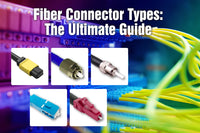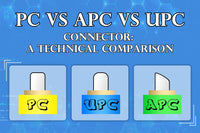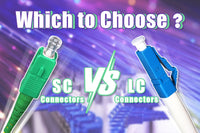Contents
With the advent of the cloud computing era, there is a growing demand for high-density, high-bandwidth connection systems in storage area networks and data centers. It makes multi-fiber connectors the primary choice for transmission media interfaces in such environments. The Multi-fiber Push On (MPO) connector is one of the earliest and most widely adopted multi-fiber connectors with a row design. However, discussions often intertwine MPO and MTP connectors. People sometimes feel confused when talking about MPO and MTP. So, are the two connectors the same thing? If not, what are the differences between MPO and MTP? This article aims to figure out everything about MPO and MTP.
What is an MPO Connector?
MPO, standing for “Multi-Fiber Push On” was developed by Nippon Telephone and Telegraph (NTT) during the 1980s. It is based on the mechanical transfer ferrule (MT ferrule) technology. MPO is an array connector that initially consisted of one row of 12-core optical fibers, and now it can accommodate more than 72 fibers. 12-core MPO with a single fiber row and 24-core MPO with double fiber rows are still very popular nowadays, and MPO connectors with 48, 60, or 72 fibers are generally used in large-scale high-density data centers. With the rise of 400G Ethernet systems, preferences are increasing for MPO connectors featuring 16 fibers per row, including both the 16-core MPO and 32-core MPO. Organizations such as IEC and TIA have standardized MPO connectors so that various manufacturers in the market can supply MPO products with similar specifications.
MPO connectors are divided into male and female types. The difference between the two types lies in the pin. A male MPO has two pins on the MT ferrule, while a female MPO has two holes there. Mating the female and male MPO connectors together can effectively avoid potential damage and ensure a stable connection.

What is the MTP® Connector?
Manufacturers not only produce MPO connectors under industry standards such as IEC 61754-7-1, IEC 61754-7-2, and TIA-604-5 (FOCIS 5), but they also improve MPO connectors to achieve higher mechanical and optical properties. For example, US Conec Ltd manufactures an improved MPO connector called the Multi-fiber Termination Push-on connector. This variant has a similar appearance and construction as the standard MPO connector and follows MT ferrule technology. MTP® is indeed the registered trademark of the new row-design fiber connector. Since the MTP connectors involve several patented designs, only manufacturers authorized by US Conec can produce them. MTP connectors are available with four standard strain relief boots. Whether to provide better protection for the cables in relatively ample space, to save space in a narrow area, or to enable the cable to stretch freely at different angles, there are strain relief jacket boots to choose from.
MTP connectors adhere to the specifications of MPO connectors, seamlessly interfacing with the latter. In short, MTP is a high-performance MPO. It is feasible to mate MPO and MTP if you ignore the performance gap.
Main Differences Between MTP® and MPO Connectors
MTP connectors have become the representative of MPO connectors in some places. The phenomenon occurs because they have mechanical design and optical performance beyond MPO connectors. So, how exactly does the MTP connector distinguish itself from the MPO connector? In the following content, we will compare them from five aspects.
Outer Housing
In contrast to conventional MPO connectors with fixed outer housing, MTP connectors feature a removable housing, providing users with enhanced versatility. This unique design empowers users to:
- Rework and repolish the MT ferrule inside the connector
- Change the gender of an assembled connector in the field
- Scan the ferrule with an interferometer after assembly
- Easily test the connector performance

Ferrule
The MT ferrule of the MPO connector is immobile, which is not conducive to providing flexibility under external force, while the MTP connector features an ingenious ferrule float. This modification is significant for improving the mechanical properties of the fiber connectors. With the floating ferrules, the connector can withstand loads without losing physical contact with its companion connector, which ensures stable data transmission, reducing the insertion loss. Since fiber optic connectors that plug directly into an active transmitter (Tx) or receiver (Rx) may be under an applied load, MTP connectors with a floating ferrule design are more advantageous in this application and favored by the engineers. Moreover, the floating ferrule helps mitigate dust accumulation on the end surface.
Guide Pin
The guide pins are essential for mating alignment. Two pairs of flat-end guide pins tend to collide with each other when connected, resulting in wear and peeling. It will harm connection precision over time. MTP connectors use stainless steel guide pins in elliptical shape instead of chamfering technology to avoid this defect of generic MPO connectors. In addition to reducing friction, the elliptical guide pin requires tighter tolerance to ensure better guidance. The debris and dust around the guide pin or the ferrule end face decreases, and MTP connectors can have a long-lasting transmission of higher performance.

Pin Clamp
The MPO connector often features a plastic pin clamp, which is easy to break and may result in lower mate/demate times. On the contrary, the MTP connector uses a metal pin clamp that is not easily damaged to reduce the risk of pin breaking. This metal pin clamp design, which helps center the push spring force, is combined with the elliptic spring design of MTP connectors to maintain the maximum distance between the spring and the multi-fiber ribbon, preventing damage to the fiber ribbon damage caused by their contact.

Insert Loss
One of the targets of mechanical upgrades made with MTP connectors is to ensure precise, stable, and tight alignment of male-female junctions. These upgrades help reduce insertion loss and improve optical performance. The difference in the insertion loss of MPO and MTP connectors is not huge, but it does exist, and this difference will affect their performance in high-speed transmission over long distances. In addition to a lower insertion loss, MTP has a higher return loss, so the signal is less attenuated as it travels through the MTP connector. People think highly of this benefit when constructing high-density network environments.
MPO vs MTP®: Function and Choice
Plug-and-play MPO/MTP connectors are a common choice not only in data centers but also in environments requiring extensive fiber usage and space conservation, such as Gigabit Ethernet infrastructure, CATV and multimedia, telecommunications networks, FTTB applications, connectivity inside optical Tx/Rx devices, etc. The introduction of MPO/MTP ultra-high density cabling is a huge improvement over traditional fiber cabling, and it can achieve the following functions:
- Reduce cable footprint and achieve high-density connections in limited space.
- Streamline installation and cable management while lowering installation costs by requiring fewer cables.
- Enlarge bandwidth capacity by consolidating numerous optical fibers into a single interface.
- Meet expanding data demands by activating additional fibers within the connectors as needed.
MTP connectors are manufactured to provide higher performance and longer service life, reducing the risk of misalignment or signal loss. As an upper product with patent technologies, the MTP connector is more expensive than the MPO connector. Due to a lower material cost and a wide range of suppliers, MPO connectors own a more competitive price.
With the strengths mentioned above, MTP is better suited for complex field installations, extremely tight spaces, long-distance applications, high signal integrity requiring scenarios, and high-standard data centers than MPO connectors. However, if your budget is limited and the performance requirements are ordinary, MPO will be a more cost-effective choice.
Final Thoughts
MPO and MTP connectors can be regarded as the same thing, but MTP connectors perform better thanks to their enhanced features and superior designs. When it comes to long-term investments in fiber link networks, MTP is unquestionably reliable and worth considering. But you should weigh your requirements and budget to decide which to choose.
FAQ
Are all MPO connectors APC (angled physical contact)?
No, most APC polishing MPO connectors are single-mode fiber connectors, intending to reach higher return loss, while multimode MPO connectors are more of the PC/UPC polishing type.
Are MPO and MTP the same?
In fact, they are almost the same. But MPO can be a generic term, and MTP is a specific brand of MPO-style connector with upgraded features. MTP is an improved variant of MPO connectors, so it is 100% compatible and interchangeable with conventional MPO connectors.
What is the difference between MT ferrule and MTP®/MPO?
MTP/MPO refers to the fiber jumper or the fiber connector that is directly used in the connection applications. MT ferrule is just the component inside the connector and cannot be used separately before assembly.
For more information on this topic, you can keep up on our blogs. While VCELINK offers general and basic information for our customers and other visitors to the website, it’s not professional advice.





Be the first one to comment.
Leave a comment